
Ground beetles are a large, cosmopolitan family of beetles, the Carabidae, with more than 40,000 species worldwide, around 2,000 of which are found in North America and 2,700 in Europe. As of 2015, it is one of the 10 most species-rich animal families. They belong to the Adephaga. Members of the family are primarily carnivorous, but some members are herbivorous or omnivorous.

Harpalinae is the largest subfamily of ground beetles, containing more than 19,000 species worldwide.
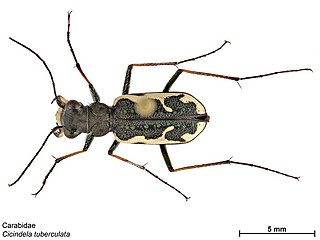
Neocicindela tuberculata is a species of tiger beetle in the family Cicindelidae, endemic to New Zealand. Its common names include common tiger beetle, moeone, and papapa, and in its laval stage penny doctor, butcher boy, kapuku, kui, kurikuri, moeone, and muremure. Neocicindela tuberculata was the first carabid beetle described from New Zealand. The species can run as fast as 5 miles per hour and are considered to be the fastest running beetles. Adult species prefer clay banks in summer and are good predators when in comes to insects.

Mecodema is a genus of large flightless ground beetle (Carabidae) endemic to New Zealand. The genus is very diverse in comparison to the other three New Zealand genera within the subtribe Nothobroscina. Mecodema is geographically widespread across both the North and South Islands, as well as numerous offshore islands, including the Three Kings Is., Poor Knights Is., Aotea and Hauturu, Kapiti Is., Stephens Is., Stewart Is., Chatham Is., Snares Is.

Mecodema oconnori is a large-bodied species of ground beetle that is found mainly on the western regions of the North Island, New Zealand. It is mainly found in native forest habitats, both intact and fragmented, and on the edges of pine plantations. Mecodema oconnori ranges from Otaki, Kapiti Coast to Raglan, but is also found in the Manawatu Gorge and some other eastern localities.

Mecodema antarcticum is a carnivorous carabid beetle that burrows in sand above the high tide mark on New Zealand sandy beaches. First described by Francis de Laporte de Castelnau in 1867 as Brullea antarctica, it has since been reassigned to Mecodema.

Oregus is a genus of beetles in the family Carabidae that is endemic to New Zealand. A 2003 taxonomic revision of the group using both morphological and DNA characters concluded that it contained four species, and identified new species from Marlborough and North Canterbury. The current species list is:
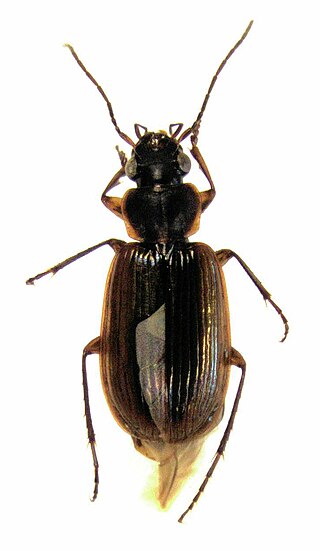
Physolaesthus is a genus of beetles in the family Carabidae, containing the following species:

Thomas Broun was a Scottish-born soldier, farmer, teacher and entomologist, who spent much of his career in New Zealand. He is known for his study of the beetles (Coleoptera) of New Zealand.

Megadromus is a genus in the beetle family Carabidae. There are at least 30 described species in Megadromus, found in New Zealand.

Neoferonia is a genus of beetles in the family Carabidae, containing the following species:

Epomis is a subgenus of ground beetle genus Chlaenius. The larvae of this subgenus are notable for being obligate role-reversal predators. Amphibians such as frogs are normally predators of beetles; however, Epomis larvae feed exclusively on amphibians.
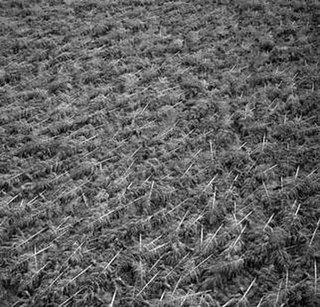
Eyrewell Forest is a small rural area in the Waimakariri District, New Zealand.

Megadromus antarcticus, also known as the “Alexander beetle”, is a member of the Carabidae family and only found in the Canterbury region of New Zealand. Megadromus antarcticus are easily recognized by their iridescent green colouration.
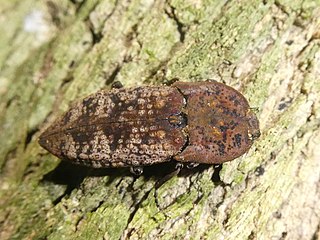
Amychus granulatus, commonly known as the Cook Strait click beetle, is a large flightless click beetle in the family Elateridae.

Anisodactylus binotatus is a species of ground beetle native to Europe. It was discovered as being introduced to Canterbury, New Zealand in 1938. Anisodactylus binotatus is a species of Carabidae, also known as the ground beetle family. Although this species of beetle has no official recorded common names, literature from England refers to it as the common shortspur beetle.
Yupa Hanboonsong is a Thai entomologist, specializing in entomophagy. Hanboonsong received her PhD in insect systematics from Lincoln University in New Zealand, and currently works as an associate professor in the entomology department at Khon Kaen University.
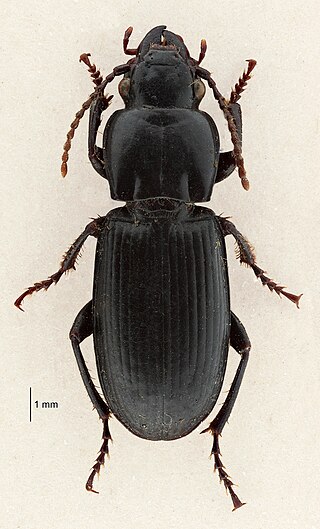
Holcaspis brevicula, the Eyrewell ground beetle, is a species of carabid beetle native to New Zealand, one of a number of small black flightless beetles in the genus Holcaspis that inhabit the dry eastern lowlands of the South Island. H. brevicula is very rare—only ten specimens have ever been collected—and critically endangered: the species was found only in Eyrewell Forest, a single plantation of exotic pine trees currently being converted into dairy farms.
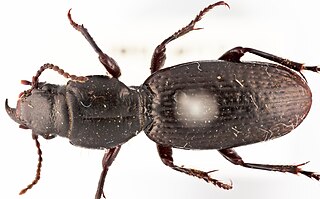
Mecodema longicolle is an endemic New Zealand ground beetle, and one of the few Mecodema species found in both the North Island and South Island.

Mecodema howitti, termed the Large Banks Peninsula ground beetle, is a carnivorous forest ground beetle in the genus Mecodema. It is endemic to Banks Peninsula, Canterbury, New Zealand, and is the largest of the 16 carabids found in the area.



















